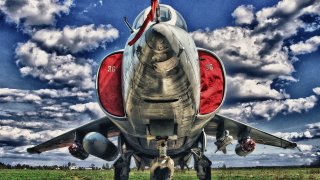Yak-38: The Russian Aircraft Carrier Fighter Jet That Was a Failure
The Yak-38 went on to see limited service with the Soviet Navy, but it wasn't all that popular with pilots for quite a few reasons.
Meet the Yak-38: During the Cold War, the Royal Air Force developed the Harrier "Jump Jet," an aircraft that went on to be a favorite of Hollywood. As Harrison Kass, writing in December of last year noted, the AV-8B Harrier was almost as much of a star in 1994's True Lies as Arnold Schwarzenegger.
Thanks to that film and others, the Harrier has become legendary.
By contrast, it is doubtful that even the most patriotic Russian filmmaker will want to put the Yak-38 (NATO reporting name "Forger") in a film. It was the Soviet's attempt to mimic the vertical/short takeoff and landing (VSTOL) operations of the Jump Jet, but it was far from a success.
Though it attempted to fulfill roughly the same role as the Harrier, the Yak-38 had numerous shortcomings, which prevented the aircraft from reaching a greater operational service career.
Origins of the Yak-38
Since the Second World War, military planners have considered the advantages of VSTOL aircraft, which could take off and land vertically or on short runways.
The British military began the development of the Harrier from lessons learned in the Korean War, and by the late 1960s, it emerged as the only truly successful VSTOL design of the Cold War era.
Moscow also saw the potential for such a warplane for its aircraft cruisers, and the A.S. Yakovlev Design Bureau JSC was charged with developing a Soviet VSTOL. Whereas the Harrier had begun essentially as a clean slate, the Yak-38 was developed from the land-based experimental demonstrator Yakovlev Yak-36. In the end, the two shared little in common – yet, it is evident that the Soviets were forced to make numerous compromises.
As previously reported, the Yak-36 had two R-27 turbojets with intakes squashed together in an open nose, with the rear nozzles capable of rotating to provide vectored thrust. Compressed air thrusters on the tail, on the tips of its undersized wings, and at the end of its unicorn-like nose boom provided directional maneuvering.
Moreover, it took five years of testing to get the Yak-36 to the point where it could transition between vertical liftoff and horizontal flight. The two dedicated lift jets behind the cockpit in addition to a single RD-27 vector thrust engine resulted in higher fuel consumption, limiting range to around two hundred miles at best, and less if it performed a vertical takeoff.
Though some 230 were produced, its service history was underwhelming.
Not Ready for Combat
The Yak-38 proved far from a perfect solution. During testing in Afghanistan, it was discovered that the fighter kicked up so much dirt, dust, and debris that it threatened to clog up the engines. At the same time, it was also a potential hazard to anyone in the vicinity.
It was only briefly employed in combat during the Soviet-Afghanistan War when it was deployed in around a dozen sorties with no notable actions recorded. Part of the issue was its limited range, while its engines reportedly struggled to perform in high temperatures.

In addition, it lacked radar, while it was equipped with just four hardpoints, along with the capacity to carry a mere 4,400 pounds of ordnance. Its weak weapons loadout typically included Kh-23 air-to-surface missiles and R-60 air-to-air missiles. It also had no internal gun.
Yakety Yak!
The Yak-38 went on to see limited service with the Soviet Navy, but it wasn't all that popular with pilots.
Its designers had observed that if one lift jet broke down, the other would spin the aircraft over on its side.
To protect the pilot, an automatic ejection system was designed to detect sharp changes in pitch and immediately eject the pilot. Predictably, that well-intentioned safety measure was triggered unnecessarily on many occasions, causing a loss of the airplane and likely the pilot's career prospects.

The Yak-38 simply lacked the payload and armament potential to have any meaningful battlefield role – while its limited range meant it was utterly unable to serve as a tool of Soviet naval power projection. Though the Soviets pressed on with the Yak-41 (NATO reporting name "Freestyle"), an improved SVTOL aircraft – the program essentially died with the Soviet Union.
By contrast, the Harrier was noted for its use in the Falklands War, where it helped the Royal Navy maintain control of the skies and seas, and later was deployed in the conflicts in Iraq and Afghanistan.
That is why the Harrier will be remembered as a legendary aircraft – and even became a favorite with Hollywood – while the Yak-38 is at most a footnote in aviation history.
Author Experience and Expertise
Peter Suciu is a Michigan-based writer. He has contributed to more than four dozen magazines, newspapers, and websites with over 3,200 published pieces over a twenty-year career in journalism. He regularly writes about military hardware, firearms history, cybersecurity, politics, and international affairs. Peter is also a Contributing Writer for Forbes and Clearance Jobs. You can follow him on Twitter: @PeterSuciu.
All images are Creative Commons.


